Fieldbus Technologies: A Detailed Analysis of Automation Systems
VerifiedAdded on 2020/05/28
|9
|1619
|48
Report
AI Summary
This report provides a comprehensive overview of Fieldbus technologies within the context of automation systems. It begins with an introduction to Fieldbus, explaining its role as a bi-directional digital communication link in industrial automation. The report then delves into different types of Fieldbus, speed requirements, and gateway technologies. The study also examines various connection types, including media, external access, and wireless technologies, such as Bluetooth, Zigbee, and Wi-Fi, and their applications in industrial settings. The report analyzes the High-Speed Ethernet for Fieldbus, including its components and benefits, along with AS-i or AS-Interface. It highlights the evolution of Fieldbus standards and protocols, such as MIL 1553B, HART, PROFIBUS, and others, and their relevance in different industries. The conclusion emphasizes the importance of proper design, installation, and maintenance practices for Fieldbus systems, including the use of network testing tools. The report also discusses how the automation systems are being utilized in gas and oil industries.
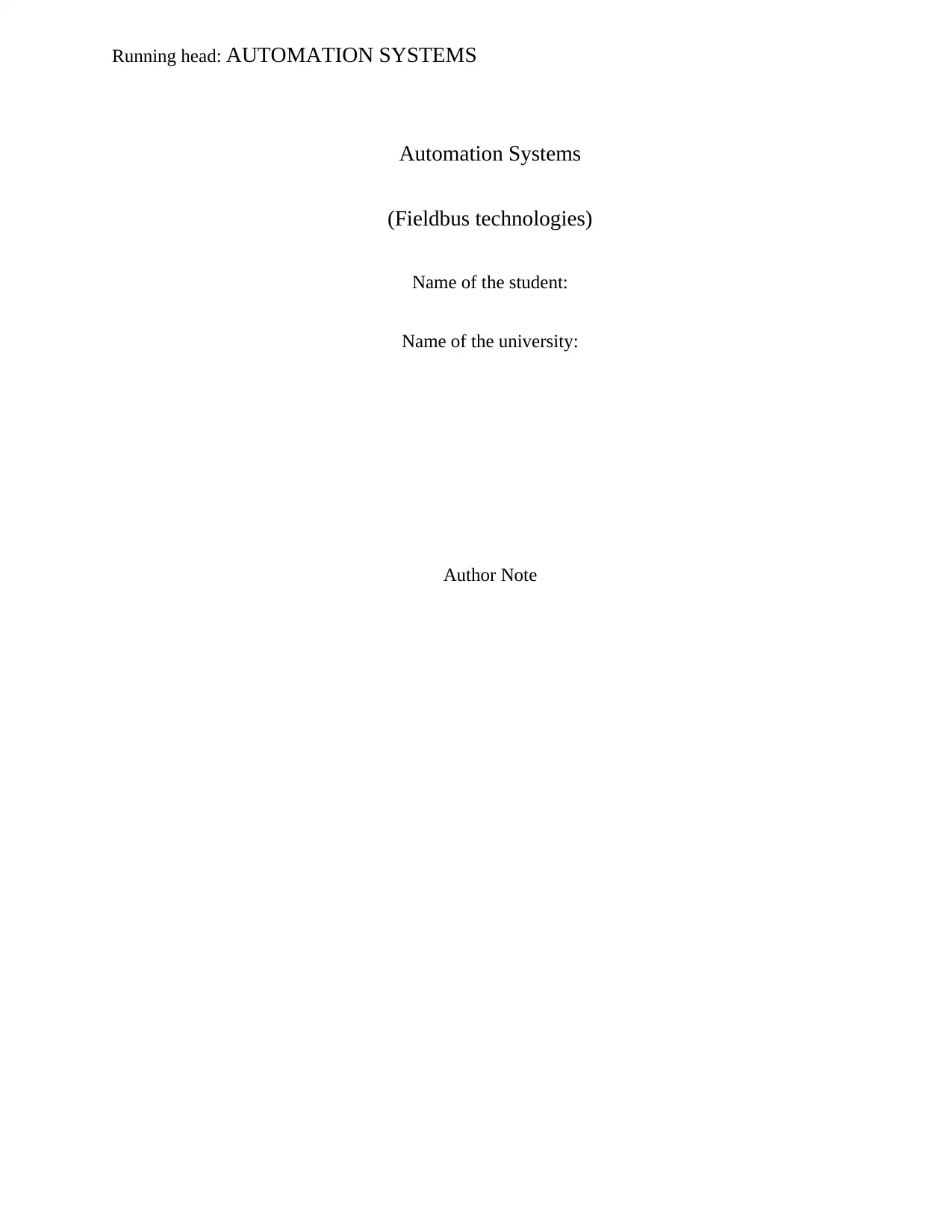
Running head: AUTOMATION SYSTEMS
Automation Systems
(Fieldbus technologies)
Name of the student:
Name of the university:
Author Note
Automation Systems
(Fieldbus technologies)
Name of the student:
Name of the university:
Author Note
Paraphrase This Document
Need a fresh take? Get an instant paraphrase of this document with our AI Paraphraser
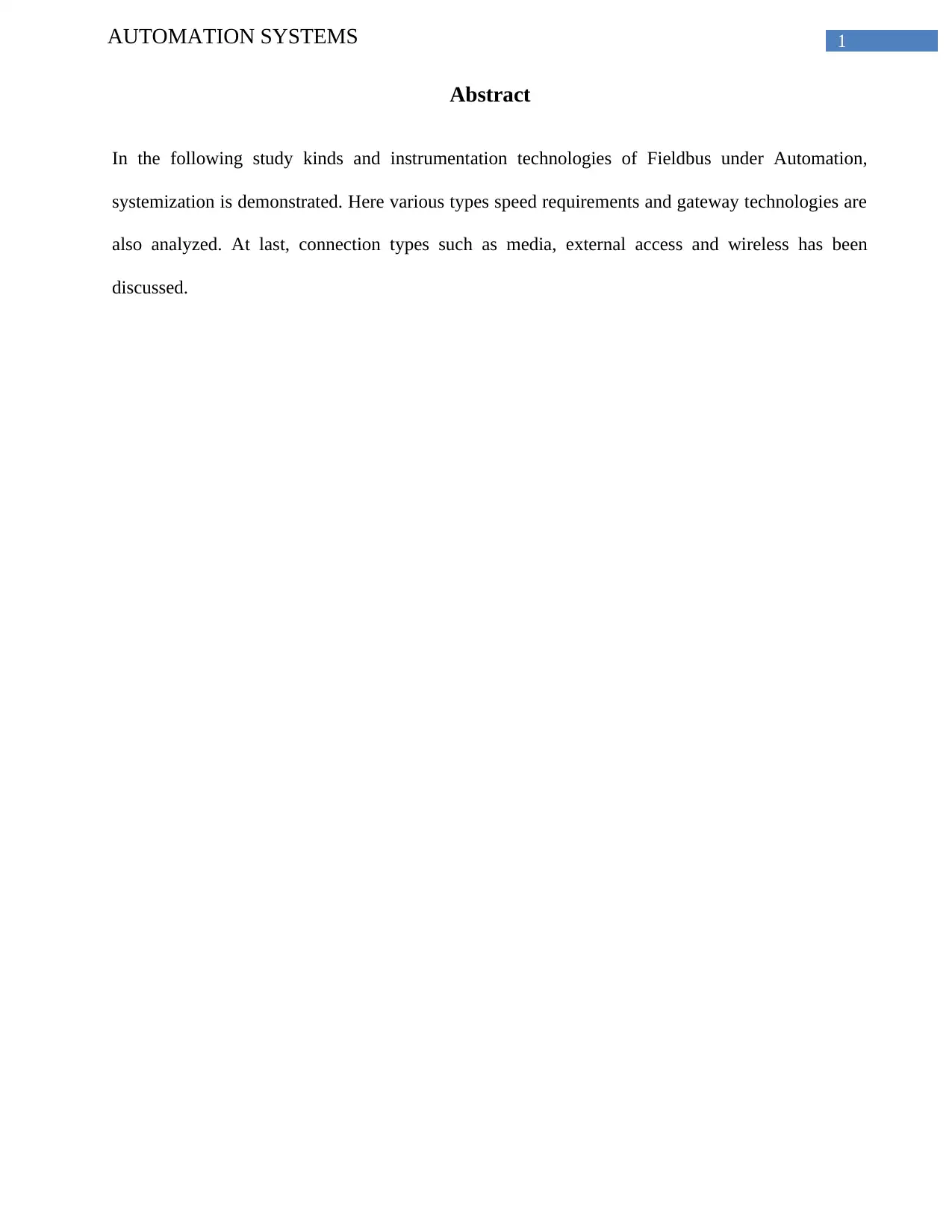
1AUTOMATION SYSTEMS
Abstract
In the following study kinds and instrumentation technologies of Fieldbus under Automation,
systemization is demonstrated. Here various types speed requirements and gateway technologies are
also analyzed. At last, connection types such as media, external access and wireless has been
discussed.
Abstract
In the following study kinds and instrumentation technologies of Fieldbus under Automation,
systemization is demonstrated. Here various types speed requirements and gateway technologies are
also analyzed. At last, connection types such as media, external access and wireless has been
discussed.
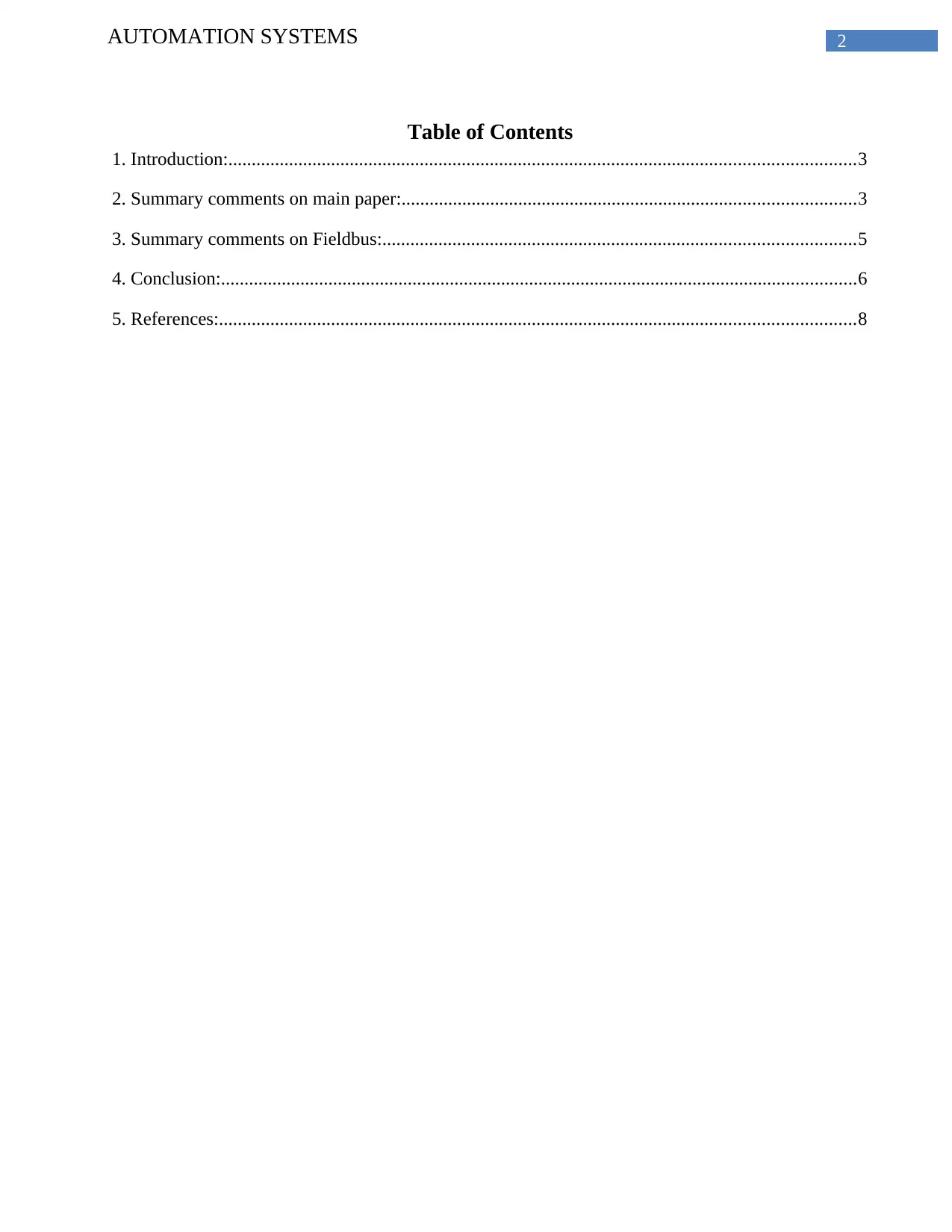
2AUTOMATION SYSTEMS
Table of Contents
1. Introduction:......................................................................................................................................3
2. Summary comments on main paper:.................................................................................................3
3. Summary comments on Fieldbus:.....................................................................................................5
4. Conclusion:........................................................................................................................................6
5. References:........................................................................................................................................8
Table of Contents
1. Introduction:......................................................................................................................................3
2. Summary comments on main paper:.................................................................................................3
3. Summary comments on Fieldbus:.....................................................................................................5
4. Conclusion:........................................................................................................................................6
5. References:........................................................................................................................................8
⊘ This is a preview!⊘
Do you want full access?
Subscribe today to unlock all pages.

Trusted by 1+ million students worldwide
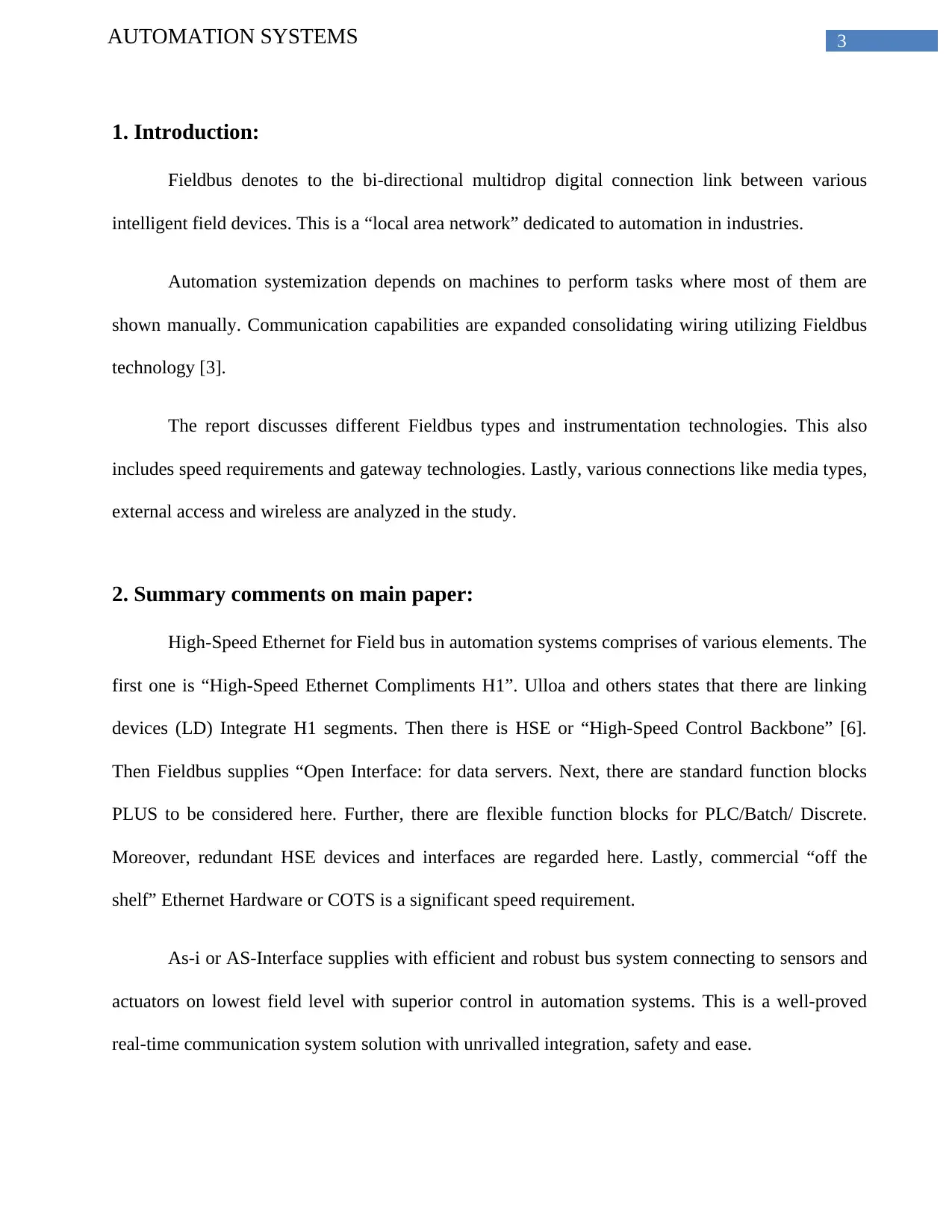
3AUTOMATION SYSTEMS
1. Introduction:
Fieldbus denotes to the bi-directional multidrop digital connection link between various
intelligent field devices. This is a “local area network” dedicated to automation in industries.
Automation systemization depends on machines to perform tasks where most of them are
shown manually. Communication capabilities are expanded consolidating wiring utilizing Fieldbus
technology [3].
The report discusses different Fieldbus types and instrumentation technologies. This also
includes speed requirements and gateway technologies. Lastly, various connections like media types,
external access and wireless are analyzed in the study.
2. Summary comments on main paper:
High-Speed Ethernet for Field bus in automation systems comprises of various elements. The
first one is “High-Speed Ethernet Compliments H1”. Ulloa and others states that there are linking
devices (LD) Integrate H1 segments. Then there is HSE or “High-Speed Control Backbone” [6].
Then Fieldbus supplies “Open Interface: for data servers. Next, there are standard function blocks
PLUS to be considered here. Further, there are flexible function blocks for PLC/Batch/ Discrete.
Moreover, redundant HSE devices and interfaces are regarded here. Lastly, commercial “off the
shelf” Ethernet Hardware or COTS is a significant speed requirement.
As-i or AS-Interface supplies with efficient and robust bus system connecting to sensors and
actuators on lowest field level with superior control in automation systems. This is a well-proved
real-time communication system solution with unrivalled integration, safety and ease.
1. Introduction:
Fieldbus denotes to the bi-directional multidrop digital connection link between various
intelligent field devices. This is a “local area network” dedicated to automation in industries.
Automation systemization depends on machines to perform tasks where most of them are
shown manually. Communication capabilities are expanded consolidating wiring utilizing Fieldbus
technology [3].
The report discusses different Fieldbus types and instrumentation technologies. This also
includes speed requirements and gateway technologies. Lastly, various connections like media types,
external access and wireless are analyzed in the study.
2. Summary comments on main paper:
High-Speed Ethernet for Field bus in automation systems comprises of various elements. The
first one is “High-Speed Ethernet Compliments H1”. Ulloa and others states that there are linking
devices (LD) Integrate H1 segments. Then there is HSE or “High-Speed Control Backbone” [6].
Then Fieldbus supplies “Open Interface: for data servers. Next, there are standard function blocks
PLUS to be considered here. Further, there are flexible function blocks for PLC/Batch/ Discrete.
Moreover, redundant HSE devices and interfaces are regarded here. Lastly, commercial “off the
shelf” Ethernet Hardware or COTS is a significant speed requirement.
As-i or AS-Interface supplies with efficient and robust bus system connecting to sensors and
actuators on lowest field level with superior control in automation systems. This is a well-proved
real-time communication system solution with unrivalled integration, safety and ease.
Paraphrase This Document
Need a fresh take? Get an instant paraphrase of this document with our AI Paraphraser
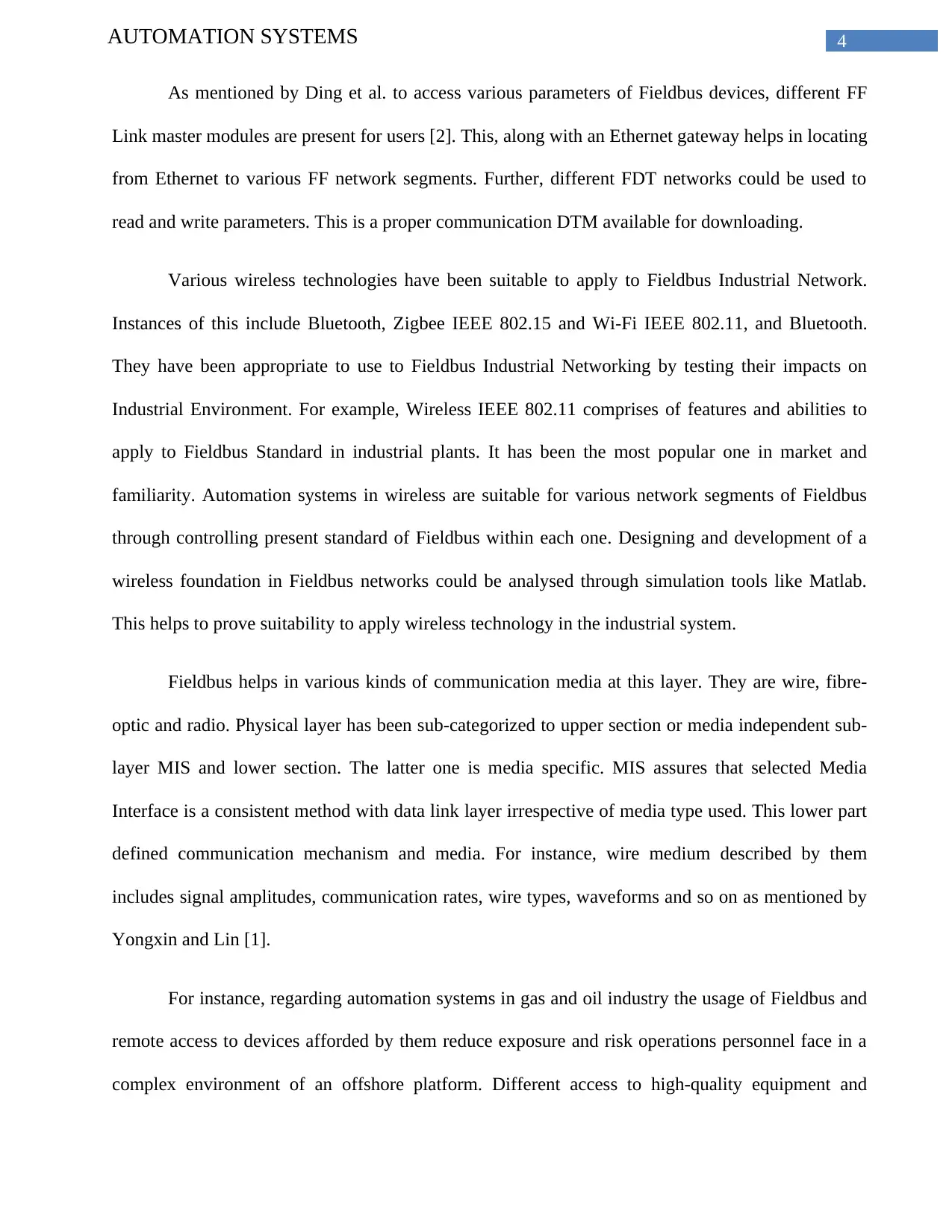
4AUTOMATION SYSTEMS
As mentioned by Ding et al. to access various parameters of Fieldbus devices, different FF
Link master modules are present for users [2]. This, along with an Ethernet gateway helps in locating
from Ethernet to various FF network segments. Further, different FDT networks could be used to
read and write parameters. This is a proper communication DTM available for downloading.
Various wireless technologies have been suitable to apply to Fieldbus Industrial Network.
Instances of this include Bluetooth, Zigbee IEEE 802.15 and Wi-Fi IEEE 802.11, and Bluetooth.
They have been appropriate to use to Fieldbus Industrial Networking by testing their impacts on
Industrial Environment. For example, Wireless IEEE 802.11 comprises of features and abilities to
apply to Fieldbus Standard in industrial plants. It has been the most popular one in market and
familiarity. Automation systems in wireless are suitable for various network segments of Fieldbus
through controlling present standard of Fieldbus within each one. Designing and development of a
wireless foundation in Fieldbus networks could be analysed through simulation tools like Matlab.
This helps to prove suitability to apply wireless technology in the industrial system.
Fieldbus helps in various kinds of communication media at this layer. They are wire, fibre-
optic and radio. Physical layer has been sub-categorized to upper section or media independent sub-
layer MIS and lower section. The latter one is media specific. MIS assures that selected Media
Interface is a consistent method with data link layer irrespective of media type used. This lower part
defined communication mechanism and media. For instance, wire medium described by them
includes signal amplitudes, communication rates, wire types, waveforms and so on as mentioned by
Yongxin and Lin [1].
For instance, regarding automation systems in gas and oil industry the usage of Fieldbus and
remote access to devices afforded by them reduce exposure and risk operations personnel face in a
complex environment of an offshore platform. Different access to high-quality equipment and
As mentioned by Ding et al. to access various parameters of Fieldbus devices, different FF
Link master modules are present for users [2]. This, along with an Ethernet gateway helps in locating
from Ethernet to various FF network segments. Further, different FDT networks could be used to
read and write parameters. This is a proper communication DTM available for downloading.
Various wireless technologies have been suitable to apply to Fieldbus Industrial Network.
Instances of this include Bluetooth, Zigbee IEEE 802.15 and Wi-Fi IEEE 802.11, and Bluetooth.
They have been appropriate to use to Fieldbus Industrial Networking by testing their impacts on
Industrial Environment. For example, Wireless IEEE 802.11 comprises of features and abilities to
apply to Fieldbus Standard in industrial plants. It has been the most popular one in market and
familiarity. Automation systems in wireless are suitable for various network segments of Fieldbus
through controlling present standard of Fieldbus within each one. Designing and development of a
wireless foundation in Fieldbus networks could be analysed through simulation tools like Matlab.
This helps to prove suitability to apply wireless technology in the industrial system.
Fieldbus helps in various kinds of communication media at this layer. They are wire, fibre-
optic and radio. Physical layer has been sub-categorized to upper section or media independent sub-
layer MIS and lower section. The latter one is media specific. MIS assures that selected Media
Interface is a consistent method with data link layer irrespective of media type used. This lower part
defined communication mechanism and media. For instance, wire medium described by them
includes signal amplitudes, communication rates, wire types, waveforms and so on as mentioned by
Yongxin and Lin [1].
For instance, regarding automation systems in gas and oil industry the usage of Fieldbus and
remote access to devices afforded by them reduce exposure and risk operations personnel face in a
complex environment of an offshore platform. Different access to high-quality equipment and
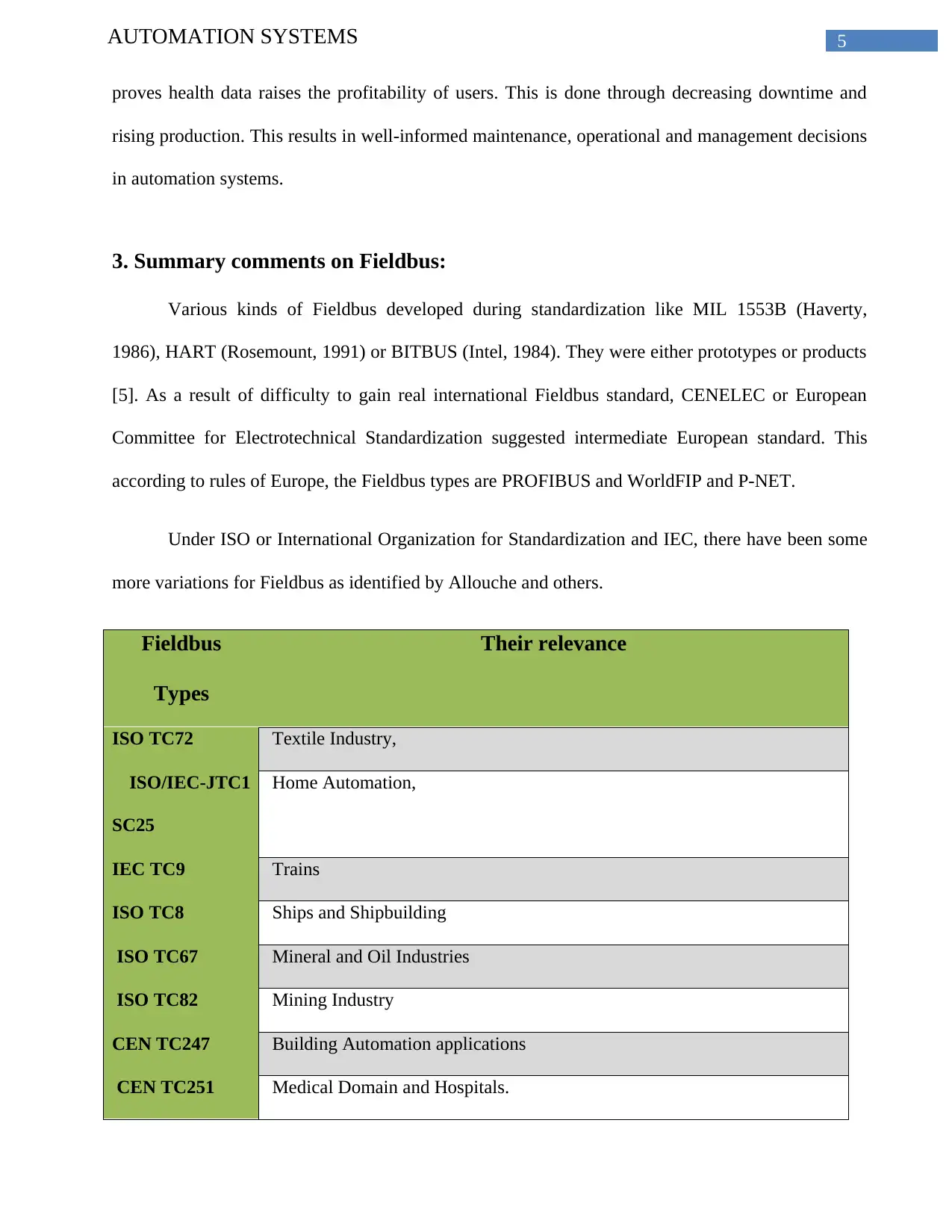
5AUTOMATION SYSTEMS
proves health data raises the profitability of users. This is done through decreasing downtime and
rising production. This results in well-informed maintenance, operational and management decisions
in automation systems.
3. Summary comments on Fieldbus:
Various kinds of Fieldbus developed during standardization like MIL 1553B (Haverty,
1986), HART (Rosemount, 1991) or BITBUS (Intel, 1984). They were either prototypes or products
[5]. As a result of difficulty to gain real international Fieldbus standard, CENELEC or European
Committee for Electrotechnical Standardization suggested intermediate European standard. This
according to rules of Europe, the Fieldbus types are PROFIBUS and WorldFIP and P-NET.
Under ISO or International Organization for Standardization and IEC, there have been some
more variations for Fieldbus as identified by Allouche and others.
Fieldbus
Types
Their relevance
ISO TC72 Textile Industry,
ISO/IEC-JTC1
SC25
Home Automation,
IEC TC9 Trains
ISO TC8 Ships and Shipbuilding
ISO TC67 Mineral and Oil Industries
ISO TC82 Mining Industry
CEN TC247 Building Automation applications
CEN TC251 Medical Domain and Hospitals.
proves health data raises the profitability of users. This is done through decreasing downtime and
rising production. This results in well-informed maintenance, operational and management decisions
in automation systems.
3. Summary comments on Fieldbus:
Various kinds of Fieldbus developed during standardization like MIL 1553B (Haverty,
1986), HART (Rosemount, 1991) or BITBUS (Intel, 1984). They were either prototypes or products
[5]. As a result of difficulty to gain real international Fieldbus standard, CENELEC or European
Committee for Electrotechnical Standardization suggested intermediate European standard. This
according to rules of Europe, the Fieldbus types are PROFIBUS and WorldFIP and P-NET.
Under ISO or International Organization for Standardization and IEC, there have been some
more variations for Fieldbus as identified by Allouche and others.
Fieldbus
Types
Their relevance
ISO TC72 Textile Industry,
ISO/IEC-JTC1
SC25
Home Automation,
IEC TC9 Trains
ISO TC8 Ships and Shipbuilding
ISO TC67 Mineral and Oil Industries
ISO TC82 Mining Industry
CEN TC247 Building Automation applications
CEN TC251 Medical Domain and Hospitals.
⊘ This is a preview!⊘
Do you want full access?
Subscribe today to unlock all pages.

Trusted by 1+ million students worldwide
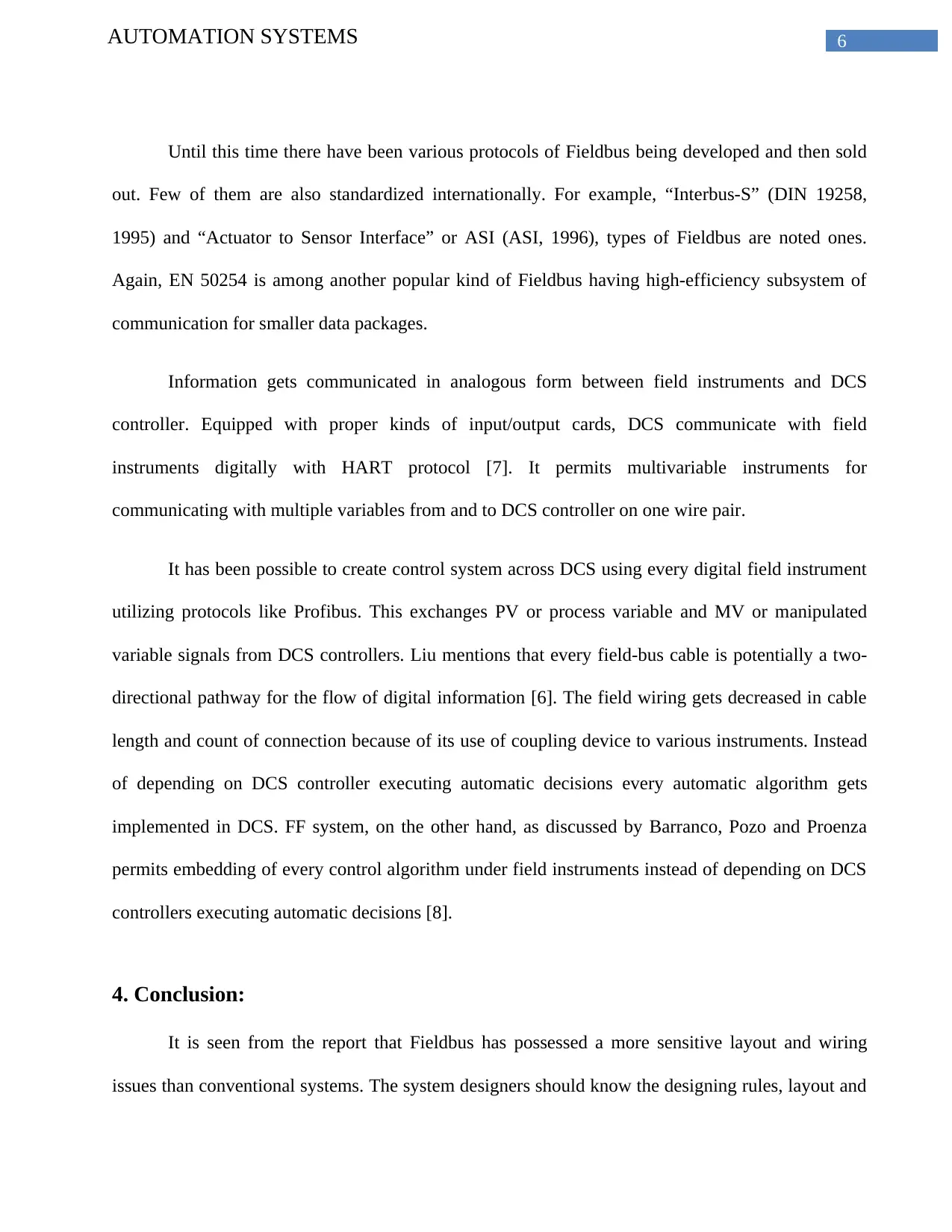
6AUTOMATION SYSTEMS
Until this time there have been various protocols of Fieldbus being developed and then sold
out. Few of them are also standardized internationally. For example, “Interbus-S” (DIN 19258,
1995) and “Actuator to Sensor Interface” or ASI (ASI, 1996), types of Fieldbus are noted ones.
Again, EN 50254 is among another popular kind of Fieldbus having high-efficiency subsystem of
communication for smaller data packages.
Information gets communicated in analogous form between field instruments and DCS
controller. Equipped with proper kinds of input/output cards, DCS communicate with field
instruments digitally with HART protocol [7]. It permits multivariable instruments for
communicating with multiple variables from and to DCS controller on one wire pair.
It has been possible to create control system across DCS using every digital field instrument
utilizing protocols like Profibus. This exchanges PV or process variable and MV or manipulated
variable signals from DCS controllers. Liu mentions that every field-bus cable is potentially a two-
directional pathway for the flow of digital information [6]. The field wiring gets decreased in cable
length and count of connection because of its use of coupling device to various instruments. Instead
of depending on DCS controller executing automatic decisions every automatic algorithm gets
implemented in DCS. FF system, on the other hand, as discussed by Barranco, Pozo and Proenza
permits embedding of every control algorithm under field instruments instead of depending on DCS
controllers executing automatic decisions [8].
4. Conclusion:
It is seen from the report that Fieldbus has possessed a more sensitive layout and wiring
issues than conventional systems. The system designers should know the designing rules, layout and
Until this time there have been various protocols of Fieldbus being developed and then sold
out. Few of them are also standardized internationally. For example, “Interbus-S” (DIN 19258,
1995) and “Actuator to Sensor Interface” or ASI (ASI, 1996), types of Fieldbus are noted ones.
Again, EN 50254 is among another popular kind of Fieldbus having high-efficiency subsystem of
communication for smaller data packages.
Information gets communicated in analogous form between field instruments and DCS
controller. Equipped with proper kinds of input/output cards, DCS communicate with field
instruments digitally with HART protocol [7]. It permits multivariable instruments for
communicating with multiple variables from and to DCS controller on one wire pair.
It has been possible to create control system across DCS using every digital field instrument
utilizing protocols like Profibus. This exchanges PV or process variable and MV or manipulated
variable signals from DCS controllers. Liu mentions that every field-bus cable is potentially a two-
directional pathway for the flow of digital information [6]. The field wiring gets decreased in cable
length and count of connection because of its use of coupling device to various instruments. Instead
of depending on DCS controller executing automatic decisions every automatic algorithm gets
implemented in DCS. FF system, on the other hand, as discussed by Barranco, Pozo and Proenza
permits embedding of every control algorithm under field instruments instead of depending on DCS
controllers executing automatic decisions [8].
4. Conclusion:
It is seen from the report that Fieldbus has possessed a more sensitive layout and wiring
issues than conventional systems. The system designers should know the designing rules, layout and
Paraphrase This Document
Need a fresh take? Get an instant paraphrase of this document with our AI Paraphraser
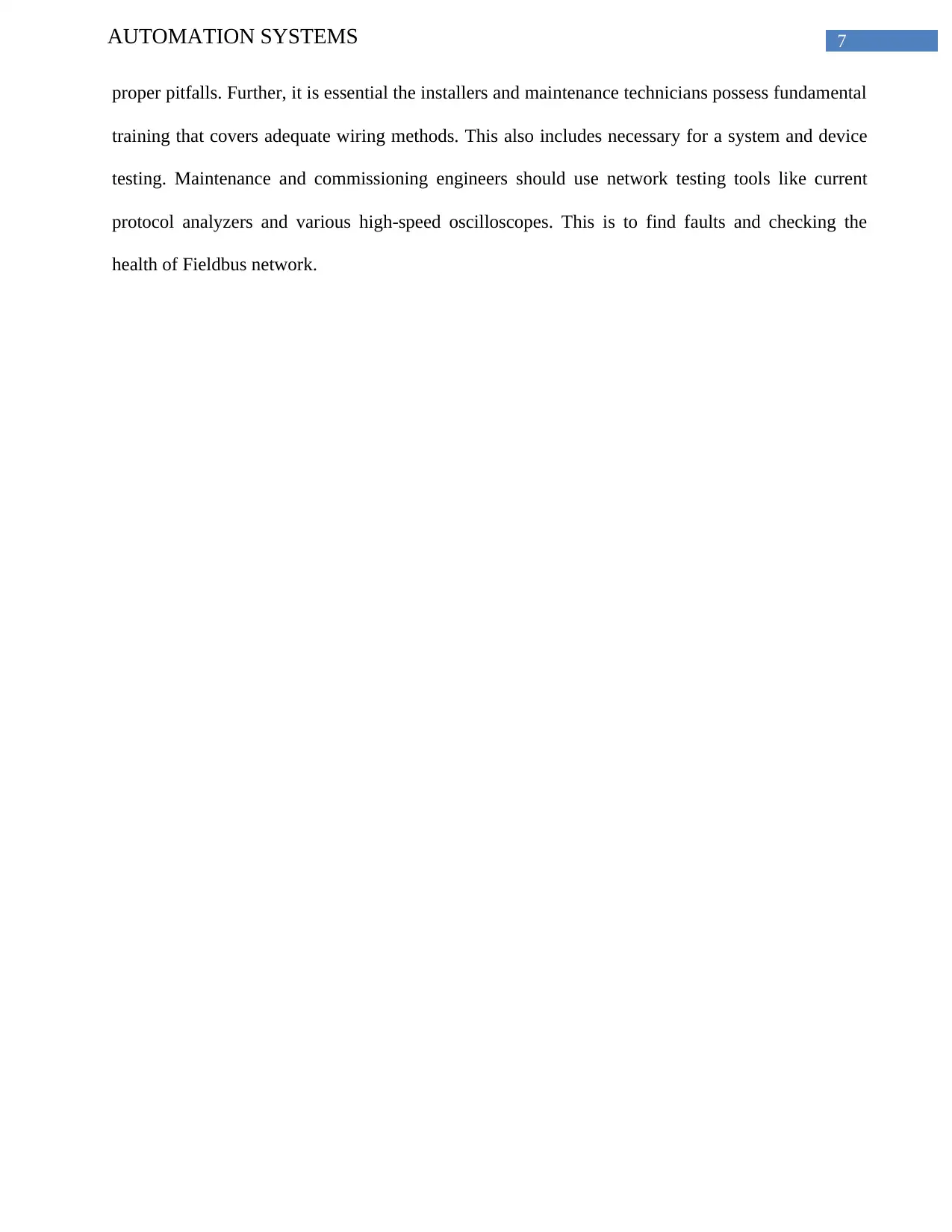
7AUTOMATION SYSTEMS
proper pitfalls. Further, it is essential the installers and maintenance technicians possess fundamental
training that covers adequate wiring methods. This also includes necessary for a system and device
testing. Maintenance and commissioning engineers should use network testing tools like current
protocol analyzers and various high-speed oscilloscopes. This is to find faults and checking the
health of Fieldbus network.
proper pitfalls. Further, it is essential the installers and maintenance technicians possess fundamental
training that covers adequate wiring methods. This also includes necessary for a system and device
testing. Maintenance and commissioning engineers should use network testing tools like current
protocol analyzers and various high-speed oscilloscopes. This is to find faults and checking the
health of Fieldbus network.
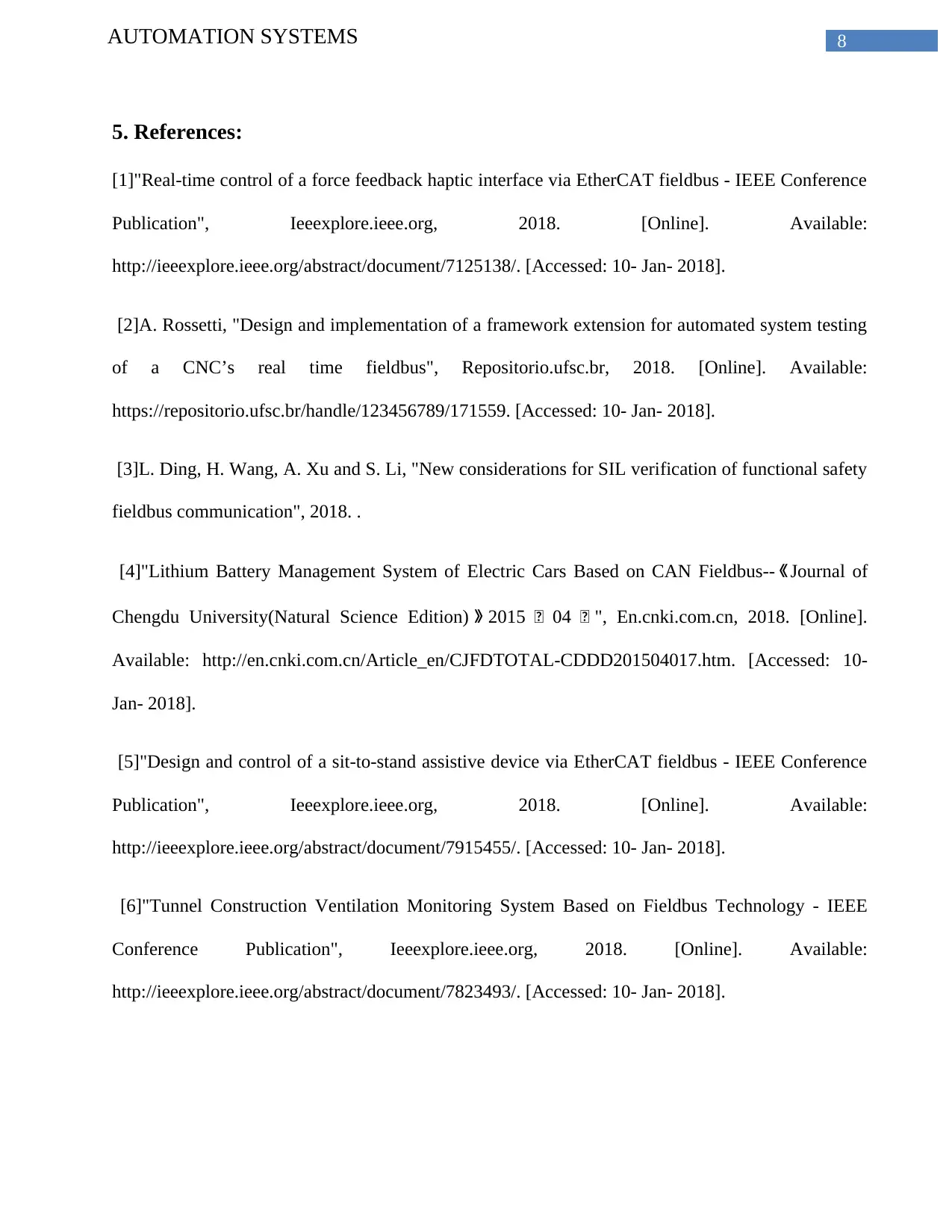
8AUTOMATION SYSTEMS
5. References:
[1]"Real-time control of a force feedback haptic interface via EtherCAT fieldbus - IEEE Conference
Publication", Ieeexplore.ieee.org, 2018. [Online]. Available:
http://ieeexplore.ieee.org/abstract/document/7125138/. [Accessed: 10- Jan- 2018].
[2]A. Rossetti, "Design and implementation of a framework extension for automated system testing
of a CNC’s real time fieldbus", Repositorio.ufsc.br, 2018. [Online]. Available:
https://repositorio.ufsc.br/handle/123456789/171559. [Accessed: 10- Jan- 2018].
[3]L. Ding, H. Wang, A. Xu and S. Li, "New considerations for SIL verification of functional safety
fieldbus communication", 2018. .
[4]"Lithium Battery Management System of Electric Cars Based on CAN Fieldbus-- 《 Journal of
Chengdu University(Natural Science Edition) 》 2015 年 04 年 ", En.cnki.com.cn, 2018. [Online].
Available: http://en.cnki.com.cn/Article_en/CJFDTOTAL-CDDD201504017.htm. [Accessed: 10-
Jan- 2018].
[5]"Design and control of a sit-to-stand assistive device via EtherCAT fieldbus - IEEE Conference
Publication", Ieeexplore.ieee.org, 2018. [Online]. Available:
http://ieeexplore.ieee.org/abstract/document/7915455/. [Accessed: 10- Jan- 2018].
[6]"Tunnel Construction Ventilation Monitoring System Based on Fieldbus Technology - IEEE
Conference Publication", Ieeexplore.ieee.org, 2018. [Online]. Available:
http://ieeexplore.ieee.org/abstract/document/7823493/. [Accessed: 10- Jan- 2018].
5. References:
[1]"Real-time control of a force feedback haptic interface via EtherCAT fieldbus - IEEE Conference
Publication", Ieeexplore.ieee.org, 2018. [Online]. Available:
http://ieeexplore.ieee.org/abstract/document/7125138/. [Accessed: 10- Jan- 2018].
[2]A. Rossetti, "Design and implementation of a framework extension for automated system testing
of a CNC’s real time fieldbus", Repositorio.ufsc.br, 2018. [Online]. Available:
https://repositorio.ufsc.br/handle/123456789/171559. [Accessed: 10- Jan- 2018].
[3]L. Ding, H. Wang, A. Xu and S. Li, "New considerations for SIL verification of functional safety
fieldbus communication", 2018. .
[4]"Lithium Battery Management System of Electric Cars Based on CAN Fieldbus-- 《 Journal of
Chengdu University(Natural Science Edition) 》 2015 年 04 年 ", En.cnki.com.cn, 2018. [Online].
Available: http://en.cnki.com.cn/Article_en/CJFDTOTAL-CDDD201504017.htm. [Accessed: 10-
Jan- 2018].
[5]"Design and control of a sit-to-stand assistive device via EtherCAT fieldbus - IEEE Conference
Publication", Ieeexplore.ieee.org, 2018. [Online]. Available:
http://ieeexplore.ieee.org/abstract/document/7915455/. [Accessed: 10- Jan- 2018].
[6]"Tunnel Construction Ventilation Monitoring System Based on Fieldbus Technology - IEEE
Conference Publication", Ieeexplore.ieee.org, 2018. [Online]. Available:
http://ieeexplore.ieee.org/abstract/document/7823493/. [Accessed: 10- Jan- 2018].
⊘ This is a preview!⊘
Do you want full access?
Subscribe today to unlock all pages.

Trusted by 1+ million students worldwide
1 out of 9
Related Documents
Your All-in-One AI-Powered Toolkit for Academic Success.
+13062052269
info@desklib.com
Available 24*7 on WhatsApp / Email
![[object Object]](/_next/static/media/star-bottom.7253800d.svg)
Unlock your academic potential
Copyright © 2020–2025 A2Z Services. All Rights Reserved. Developed and managed by ZUCOL.





